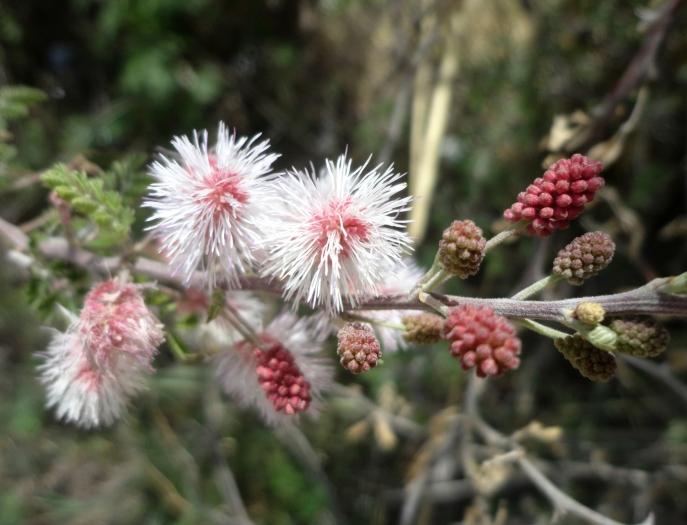Catclaw Mimosa
(Mimosa aculeaticarpa)
Catclaw Mimosa (Mimosa aculeaticarpa)
/
/

Juan Carlos Fonseca Mata
CC BY 4.0
Image By:
Juan Carlos Fonseca Mata
Recorded By:
Copyright:
CC BY 4.0
Copyright Notice:
Photo by: Juan Carlos Fonseca Mata | License Type: CC BY 4.0 | License URL: http://creativecommons.org/licenses/by/4.0/ | Rights Holder: Juan Carlos Fonseca Mata | Publisher: iNaturalist | Date Created: 2019-07-27T01:40Z |


















































Estimated Native Range
Summary
Mimosa aculeaticarpa, commonly known as Catclaw Mimosa, is a deciduous shrub native to arid and semi-arid regions including deserts, grasslands, and scrublands in the Southwestern United States and Central and Northeastern Mexico. This plant typically grows to a height of 3-6 feet (0.9-1.8 meters) and a width of 4-6 feet (1.2-1.8 meters), featuring a thorny, dense, and spreading form. The Catclaw Mimosa is adorned with delicate, bipinnate leaves and bears fragrant, fluffy white and pink flowers during the spring and summer months, which are attractive to pollinators such as bees and butterflies.
The Catclaw Mimosa is valued for its drought tolerance and ability to thrive in poor soils, making it an excellent choice for xeriscaping and naturalistic plantings in arid climates. Its thorns make it a good barrier plant for creating defensive hedges. It is also used for erosion control due to its extensive root system. Gardeners should note that it requires minimal water once established, prefers well-drained soils, and can tolerate both full sun and partial shade. While generally disease-resistant, it can be susceptible to root rot if overwatered. The plant’s thorns can be a concern in high-traffic areas, and it may spread aggressively in some conditions.CC BY-SA 4.0
The Catclaw Mimosa is valued for its drought tolerance and ability to thrive in poor soils, making it an excellent choice for xeriscaping and naturalistic plantings in arid climates. Its thorns make it a good barrier plant for creating defensive hedges. It is also used for erosion control due to its extensive root system. Gardeners should note that it requires minimal water once established, prefers well-drained soils, and can tolerate both full sun and partial shade. While generally disease-resistant, it can be susceptible to root rot if overwatered. The plant’s thorns can be a concern in high-traffic areas, and it may spread aggressively in some conditions.CC BY-SA 4.0
Plant Description
- Plant Type: Shrub
- Height: 3-6 feet
- Width: 4-6 feet
- Growth Rate: Moderate
- Flower Color: White, Pink
- Flowering Season: Spring, Summer
- Leaf Retention: Deciduous
Growth Requirements
- Sun: Full Sun, Part Shade
- Water: Low
- Drainage: Fast
Common Uses
Bee Garden, Bird Garden, Butterfly Garden, Drought Tolerant, Hummingbird Garden, Low Maintenance
Natural Habitat
native to arid and semi-arid regions including deserts, grasslands, and scrublands in the Southwestern United States and Central and Northeastern Mexico
Other Names
Common Names: Mimosa, Garabatillo, Garruno
Scientific Names: , Mimosa aculeaticarpa, Mimosa arida, Mimosopsis aculeaticarpa,
GBIF Accepted Name: Mimosa aculeaticarpa Ortega